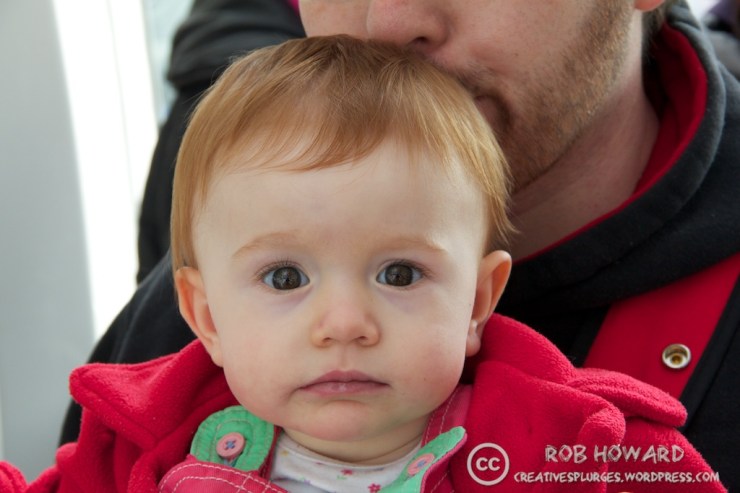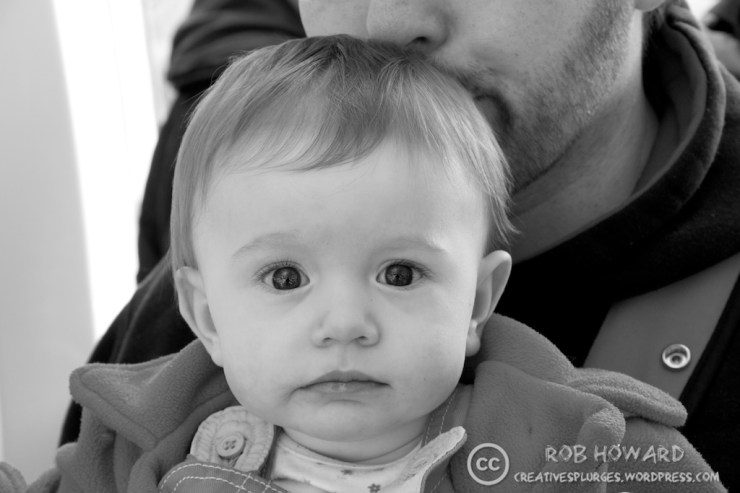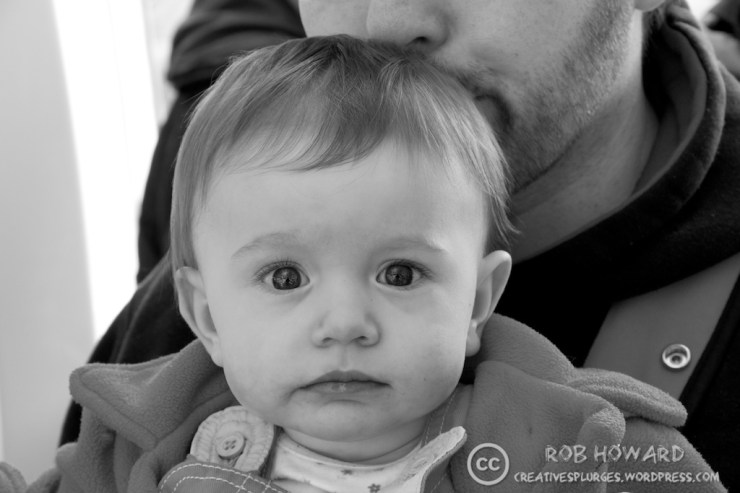Last weekend we went out for a trip into London for my sister-in-law’s birthday. I’m still going through those photos, which will be in a later post, but one of the shots I took warranted more editing than usual, and it made me think.
This is the original, as shot, image of my niece Alayna:

I liked it; I had managed to capture her eyes big and wide and bright (even if her expression was a little less than cheery).
However, I felt I could improve the image. Like many of my portraits, I felt it could benefit from being monochromed, but before I got that far, she seemed to have a dirty face, which needed cleaning up.
Wanting to enhance the shot and make it more presentable, started to play about with some of Aperture’s post-processing features.
First, I used the ‘Retouch’ brush to remove some of her lunch from her face.
Then, I monochromed the image, adjusting exposure and contrast in the process.
This is normally where I’d stop when processing an image. However there were still a few things bugging me about it. In darkening the image to bring out the texture of her face, I’d lost the effect of the eyes that originally captivated me about the image.
So, I tried something different. I pushed the levels back up to brighten her eyes…
… then broke out the burn tool to re-darken her face.
I then added a digital vignette, which I often do to give a gentle nudge to the contrast and focus the image.
I still wasn’t happy. The background was a bit too busy; her dad is too much in focus and pulls her face into the background. So I used the blur brush to defocus the background.
All in all, quite a lot more work than I would normally put into an image. To see the images in direct comparison, here is a slideshow:
Normally I wouldn’t put this much effort into an image. It’s a bit of a Catch-22, in that if the image is good as-shot I won’t feel the need to edit it, and if it isn’t I will usually delete it without spending much time seeing if it can be altered into an interesting image. This time, I wanted to fight to get Alayna’s eyes to work, and felt like trying out the capabilities of the software a little more in order to achieve it.
However, I find myself wondering two things: was it worth it, and is it okay to edit a photo so much?
I’ve obviously made a few changes from the original. Is it right to do this much manipulation to an image?
Minor tweaks are quite common; I do them all the time. A nudge of the white balance, adjusting the exposure, straightening the photo – all techniques I have to use from time to time. But there has to be a line somewhere – ‘airbrushing’ of models in photos hit the news a few years ago and it’s still news now whenever someone gets called up on it.
The only answer I have is, as long as the image is not being used to mislead anyone, then any editing is probably fine – even, there are many photographers out there whose specialty is heavily Photoshopped images. This morning I caught this video from TED about one photographer talking about his amazing, digitally altered photographs, and how he still, despite his material, strives for realism.
I also spent a lot longer on this image than I normally would, and I’m quite pleased with the end result. I prefer the processed image, but I often find my readers don’t always agree with my opinions on my photos; they often prefer the images I almost cut from sets whilst not being at all moved by my favourites. What do you guys think? Worth it?







I like your original photo and final edit equally. The final edit gives a professional look as in child is clearly the focus and the photo is clean and sharp. The original however has the sings of lunch, and childish activity to it.
My favorite part of photography is the editing. I only have very basic tools at my disposal, but I love to bring up colors and to make things pop. I know they may look way over done, but that is the fun of it for me. I always keep that original though, the moment that was captured often outshines the finished product.
Blessings to you
Shaey
LikeLike
Thanks for your input!
One of the things I really love about Aperture is its completely non-destructive editing. I can make whatever changes to the image I want – heavily cropping, desaturating, retouching or the likes – and the RAW image is still preserved, safe and sound. I can even deactivate specific edits – which is what I did for this post, I deactivated the monochroming, blurring, retouching etc and reactivated them one-by-one, exporting a version of the photo each time.
I know what you mean about the editing, I love copying photos from the card to the computer for the first time and getting to those finished photos!
LikeLike
I think you did a good job. There is nothing wrong with cleaning up a child face in post-production (just the dirt not airbrushing the skin). If a Mum and Dad hired you, they would probably sigh and request you get rid of the dirt anywway. In terms of the bokeh, you ideally would of shot at a lower f-stop. This would have avoided a lot of post-production. But the end result looks very good. If you did not show the previous picture, no-one would of ever known it was shot at f10.
LikeLike
I normally shoot at a wider aperture because I like bokeh in my images, but I was taking cityscapes in bright sunlight and so had closed the aperture up a bit for that, and forgot to open it up again before taking this shot.
Thanks for commenting!
LikeLike
I’ll be interested to hear what others have to say about this, as I often have this question myself. I’m just not an experienced enough photographer yet to have all of my settings perfectly reflect the shot I intend to get at the precise moment the shot’s available. So, I think post-production “tweaking” is okay for me. But I will keep striving to get the shot I want right out of the gate! 🙂
LikeLike
This is another great point – I think many people would consider themselves to be learning the skills of photography, and the ability to use software to correct any errors is quite invaluable. It also serves to highlight exactly what you could have done better or what you may want to consider next time. Like this shot, as someone mentioned, could have been taken at a lower f-stop to get the background smooth without the need for blurring in Photoshop which is an instant lesson learned that may not have been so obvious if Rob hadn’t played with blurring to see how it looked. I’d think most photographers are striving for the ability to get exactly the desired image out of the gate, and software is perhaps a way of seeing how to!
LikeLike
Definitely a valid point.
I’d like to add, my problem currently is thinking about things. I know that a bigger aperture equates to a shallower depth of field and thus, a nice blurred background; something I learnt along the way by making the same mistakes we all make. The problem is, I rarely seem to think about that at the time I fire the shutter. That’s the hurdle I need to overcome.
LikeLike
this is something i’ve always had a definitive opinion about. the best image is always the original image, in my opinion. photographers have been taking beautiful, artistic, cool photos for decades, long before photo editing software came along, and i really believe that photography is a talent that’s part inherent and part learned, not part photoshop skills.
in our time, however, photoshop is a necessary evil because people want smoother skin, brighter eyes, and cleaner kids’ faces. photo editing is cheaper than plastic surgery 🙂 i use photoshop and iphoto myself but i do my best to maintain as much realism as i can in my photos.
but remember when you were younger and you’d pick up freshly processed photos from your local photo lab? remember how excited you were to see how they turned out? you just had to look through them right there, no waiting til you got home. some made you cringe, some made you laugh, some made you really proud – and when you look back at them now, don’t they still illicit those same feelings? perfectly touched up photos rarely do the same thing.
LikeLike
That is what is great about digital photography – infinite creation. A single photo and yet you can alter it to your taste, or to the taste of anyone else who has a vested interest in the outcome!
LikeLike
Actually, I usually have the opposite criticism of an image: did the photographer capture and maximize the use of information in the shot? When I see a shot that is blocked or blown, or has other obvious flaws, especially if I know the information exists in the negative or digital capture, then I think the person did not work hard enough. This is not a digital question, btw, it’s as old as photography and the whole basis behind previsualization and the Zone system.
I also think that this reflects on your growth as a photographer. As time goes on you may capture more of this in camera, or just make it part of your workflow. There are images I’ve made 100 prints of and still not been happy, only to learn to make better negatives and get the best print in only 3 tries. Of course that freed me up to consider how new techniques would improve even those images….
It’s not overworked if you get the result you want.
LikeLike
I definitely agree with you, the processed image looks better than the original. The background was distracting, so the blurring made the biggest different to me, coupled with the slight brightening.
I can never sort out how I feel about the amount of work done to images, I think you’re right that as long as it’s not intentionally misleading then it’s not a problem. There’s a measure of skill involved in processing that means it’s not as if you did no work to get a better result. There’s another level you can go to where the application of filters, or HDR, takes a photo beyond simple photography into something I’d be more likely to consider ‘art’ for want of a better term. I actually quite like a lot of work like that, and like to dabble myself, but usually after producing a ‘normal’ photo.
LikeLike
Even though the original picture is beautiful, I really like the way her eyes are intensified in the final image 🙂
LikeLike
If I exclude Photo Journalism, documentary and commercials ..I believe the shot is my creative property .. but even though I put no hard boundaries for myself , I always find myself living in a confined space with invisible walls..
LikeLike